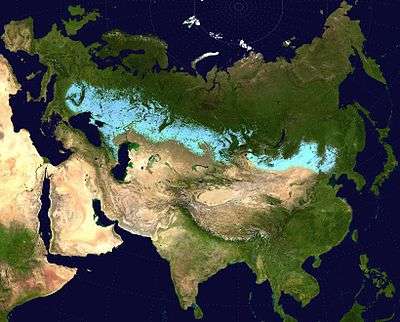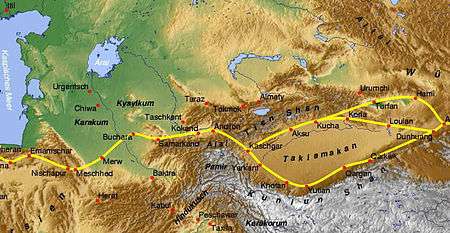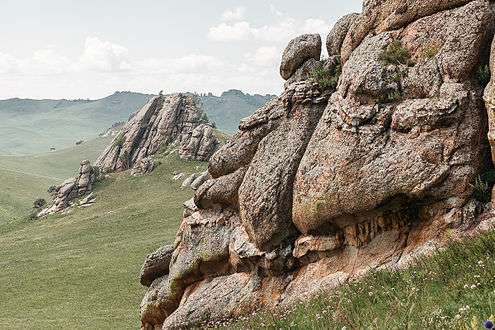Eurasian Steppe
The Eurasian Steppe, also called the Great Steppe or the steppes, is the vast steppe ecoregion of Eurasia in the temperate grasslands, savannas, and shrublands biome. It stretches from Moldavia through Ukraine, Russia, Kazakhstan, Xinjiang and Mongolia to Manchuria, with one major exclave located mostly in Hungary, the Puszta.[1]
The steppe has connected Eastern Europe, Central Asia, China, South Asia, and the Middle East economically, politically, and culturally through overland trade routes, most notably the Silk Road during antiquity and the Middle Ages, and the Eurasian Land Bridge in the modern era. It has been home to nomadic empires and many large tribal confederations and ancient states throughout history, such as the Xiongnu, Scythia, Cimmeria, Sarmatia, Hunnic Empire, Chorasmia, Transoxiana, Sogdiana, Xianbei, Mongols, and Göktürk Khaganate.

Geography
Divisions

The Eurasian Steppe extends thousands of miles from near the mouth of the Danube River almost to the Pacific Ocean. It is bounded on the north by the forests of Russia and Siberia. There is no clear southern boundary although the land becomes increasingly dry as one moves south. The steppe narrows at two points, dividing it into three major parts.
Western Steppe

- The Western Steppe begins near the mouth of the Danube and extends northeast almost to Kazan and then southeast to the southern tip of the Ural Mountains. Its northern edge was a broad band of forest-steppe which has now been obliterated by the conversion of the whole area to agricultural land. In the southeast the Black Sea-Caspian Steppe extends between the Black Sea and Caspian Sea to the Caucasus Mountains. In the west, the Great Hungarian Plain is an island of steppe separated from the main steppe by the mountains of Transylvania. On the north shore of the Black Sea, the Crimean Peninsula has some interior steppe and ports on the south coast which link the steppe to the civilizations of the Mediterranean basin.
Ural-Caspian Narrowing
- The Ural Mountains extend south to a point about 650 km (400 mi) northeast of the Caspian Sea. This is not a major barrier to movement, but the area near the Caspian is quite dry.
Central Steppe

- The Central Steppe or Kazakh Steppe extends from the Urals to Dzungaria. To the south, it grades off into semi-desert and desert which is interrupted by two great rivers, the Amu Darya (Oxus) and Syr Darya (Jaxartes), which flow northwest into the Aral Sea and provide irrigation agriculture. In the southeast is the densely populated Fergana Valley and west of it the great oasis cities of Tashkent, Samarkand and Bukhara along the Zarafshan River. The southern area has a complex history (see Central Asia and Greater Iran), while in the north, the Kazakh Steppe proper was relatively isolated from the main currents of written history.
Dzungarian Narrowing
On the east side of the former Sino-Soviet border mountains extend north almost to the forest zone with only limited grassland in Dzungaria.
Eastern Steppe
- Xinjiang is the northwestern province of China. The east-west Tien Shan Mountains divide it into Dzungaria in the north and the Tarim Basin to the south. Dzungaria is bounded by the Tarbagatai Mountains on the west and the Mongolian Altai Mountains on the east, neither of which is a significant barrier. Dzungaria has good grassland around the edges and a central desert. It often behaved as a westward extension of Mongolia and connected Mongolia to the Kazakh steppe. To the north of Dzungaria are mountains and the Siberian forest. To the south and west of Dzungaria, and separated from it by the Tianshan Mountains, is an area about twice the size of Dzungaria, the oval Tarim Basin. The Tarim Basin is too dry to support even a nomadic population, but around its edges rivers flow down from the mountains giving rise to a ring of cities which lived by irrigation agriculture and east-west trade. The Tarim Basin formed an island of near civilization in the center of the steppe. The Northern Silk Road went along the north and south sides of the Tarim Basin and then crossed the mountains west to the Ferghana Valley. At the west end of the basin the Pamir Mountains connect the Tien Shan Mountains to the Himalaya Mountains. To the south, the Kunlun Mountains separate the Tarim Basin from the thinly peopled Tibetan Plateau.
- The Mongol Steppe includes both Mongolia and the Chinese province of Inner Mongolia. The two are separated by a relatively dry area marked by the Gobi Desert. South of the Mongol Steppe is the high and thinly peopled Tibetan Plateau. The northern edge of the plateau is the Gansu or Hexi Corridor, a belt of moderately dense population that connects China proper with the Tarim Basin. The Hexi Corridor was the main route of the Silk Road. In the southeast the Silk Road led over some hills to the east-flowing Wei River valley which led to the North China Plain.

- Manchuria is a special case. Westerners tend to think of Manchuria as the northeast projection of China that they see on maps. The Chinese now call this, or the eastern two thirds of it, Northeast China. The dryer western third west of the Greater Khingan Mountains has normally been part of Inner Mongolia. Before 1859, Manchuria also included Outer Manchuria to the north and east, which is now part of Russia. South of the Khingan Mountains and north of the Taihang Mountains, the Mongolian-Manchurian steppe extends east into Manchuria as the Liao Xi steppe. In Manchuria, the steppe grades off into forest and mountains without reaching the Pacific. The central area of forest-steppe was inhabited by pastoral and agricultural peoples, while to the north and east was a thin population of hunting tribes of the Siberian type.
Fauna
There seems to be little information about steppe ecology before the coming of nomadic pastoralism. The primary animals raised were sheep and goats with fewer cattle than one might expect. Camels were used in the drier areas for transport as far west as Astrakhan. There were some yaks along the edge of Tibet. The horse was used for transportation and warfare.
The horse was first domesticated on the Pontic–Caspian or Kazakh steppe sometime before 3000 BC, but it took a long time for mounted archery to develop and the process is not fully understood. The stirrup does not seem to have been completely developed until 300 AD. (See Stirrup, Saddle, Composite bow, Domestication of the horse and related articles.)
Ecoregions
The World Wide Fund for Nature divides the Euro-Asian Steppe's temperate grasslands, savannas, and shrublands into a number of ecoregions, distinguished by elevation, climate, rainfall, and other characteristics, and home to distinct animal and plant communities and species, and distinct habitat ecosystems.
- Alai-Western Tian Shan steppe (Kazakhstan, Tajikistan, Uzbekistan)
- Altai steppe and semi-desert (Kazakhstan)
- Daurian forest steppe (China, Mongolia, Russia)
- Emin Valley steppe (China, Kazakhstan)
- Kazakh forest steppe (Kazakhstan, Russia)
- Kazakh steppe (Kazakhstan, Russia)
- Kazakh upland (Kazakhstan)
- Mongolian-Manchurian grassland (China, Mongolia, Russia)
- Pontic steppe (Moldova, Romania, Russia, Ukraine)
- Sayan Intermontane steppe (Russia)
- Selenge-Orkhon forest steppe (Mongolia, Russia)
- South Siberian forest steppe (Russia)
- Tian Shan foothill arid steppe (China, Kazakhstan, Kyrgyzstan)
- Pannonian steppe[2] (Hungary, Romania, Serbia, Croatia, Slovakia, Austria, Slovenia)
Human activities
Trade habits
The major centers of population and high culture in Eurasia are Europe, the Middle East, India and China. For some purposes it is useful to treat Greater Iran as a separate region. All these regions are connected by the steppe. The Silk Road started in the Guanzhong region of China and ran west along the Hexi Corridor to the Tarim Basin. From there it went southwest to Greater Iran and turned southeast to India or west to the Middle East and Europe. A minor branch went northwest along the great rivers and north of the Caspian Sea to the Black Sea. When faced with a rich caravan the steppe nomads could either rob it, or tax it, or hire themselves out as guards. Economically these three forms of taxation or parasitism amounted to the same thing. Trade was usually most vigorous when a strong empire controlled the steppe and reduced the number of petty chieftains preying on trade. The silk road first became significant and Chinese silk began reaching the Roman Empire about the time that the Emperor of Han pushed Chinese power west to the Tarim Basin.
Agriculture
The nomads would occasionally tolerate colonies of peasants on the steppe in the few areas where farming was possible. These were often captives who grew grain for their nomadic masters. Along the fringes there were areas that could be used for either plowland or grassland. These alternated between one and the other depending on the relative strength of the nomadic and agrarian heartlands. In the last few hundred years the Russian steppe and much of Inner Mongolia has fallen to the plow. The fact that most of the Russian steppe is not irrigated implies that it was held in grass due to the military strength of the nomads.
Language
According to the most widely held hypothesis of the origin of the Indo-European languages, the Kurgan hypothesis, their common ancestor is thought to have originated on the Pontic-Caspian steppe. The Tocharians were an early Indo-European branch in the Tarim Basin. At the beginning of written history the entire steppe population west of Dzungaria spoke Iranian languages. From about 500 AD the Turkic languages replaced the Iranian languages first on the steppe and later in the oases north of Iran. The reasons for this are poorly understood. After 1077 a group of Turkic speakers pushed into Anatolia and founded the modern nation of Turkey. Similarly, Hungarian speakers, a branch of the Uralic language family, who previously lived in the steppe in what is now Southern Russia, settled in the Carpathian basin in year 895. Mongolic languages are in Mongolia. In Manchuria one finds Tungusic languages and some others.
Religion
If the Kurgan hypothesis of Indo-European origins is accepted, then the earliest hypothesised steppe religion would have been the mythology of the Indo-Europeans. Later, Tangriism was introduced by Turko-Mongol nomads. Nestorianism and Manichaeism spread to the Tarim Basin and into China but they never became an established majority religion. Buddhism spread from India north to the Tarim Basin and found a new home in China. By about 1400 the entire steppe west of Dzungaria had adopted Islam. By about 1600 Islam was established in the Tarim Basin while Dzungaria and Mongolia had adopted Tibetan Buddhism.
History
Warfare
Raids between tribes were prevalent throughout the region's history. This is connected to the ease with which a defeated enemy's flocks can be driven away, which makes raiding profitable. In relation to sedentary societies, the horse gave the nomads the supreme advantage of mobility. Horsemen can raid a village and be gone with their loot before a land army can be gathered. When confronted with superior infantry, horsemen can simply ride away and regroup where there are no soldiers. Outside of Europe and parts of the Middle East, agrarian societies had difficulty raising a sufficient number of war horses and often had to buy them from their nomadic enemies. Nomads could not easily be pursued onto the steppe since the steppe could not easily support a land army. If the Chinese sent an army into Mongolia, the nomads would flee and come back when the Chinese ran out of supplies. But the steppe nomads were relatively few and their rulers had difficulty holding together enough clans and tribes to field a large army. If they conquered an agricultural area they often lacked the skills to administer it. If they tried to hold agrarian land they gradually absorbed the civilization of their subjects, lost their nomadic skills and were either absorbed by their subjects or driven out.
Relations with neighbors
Along the northern fringe the nomads would collect tribute from and blend with the forest tribes (see Khanate of Sibir, Buryats). From about 1240 to 1480 Russia paid tribute to the Golden Horde. South of the Kazakh steppe the nomads blended with the sedentary population, partly because the Middle East has significant areas of steppe (taken by force in past invasions) and pastoralism. There was a sharp cultural divide between Mongolia and China and almost constant warfare from the dawn of history until 1757. The nomads collected large amounts of tribute from the Chinese and several Chinese dynasties were of steppe origin. Perhaps because of the mixture of agriculture and pastoralism in Manchuria its inhabitants knew how to deal with both nomads and settled populations and were able to conquer much of northern China when both Chinese and Mongols were weak.
Historical peoples and nations
- Chorasmia 13th-3rd centuries BC
- Cimmerians 12th-7th centuries BC
- Magyars 11th century BC - 8th century AD
- Scythians 8th–4th centuries BC
- Sogdiana 8th–4th centuries BC
- Issedones 7th-1st century BC
- Massagatae 7th-1st century BC
- Thyssagetae 7th-3rd century BC
- Donghu 7th - 2nd century BC
- Dahae 7th BC-5th century AD
- Saka 6th-1st centuries BC
- Sarmatians 5th century BC – 5th century AD
- Bulgars 7th century BC–7th century AD[3]
- Transoxiana 4th century BC - 14th century AD
- Xiongnu 3rd century BC - 2nd century AD
- Iazyges 3rd century BC - 5th century AD
- Yuezhi 2nd century BC - 1st century AD
- Wusun 1st century BC - 6th century AD
- Xianbei 1st-3rd centuries
- Goths 3rd–6th centuries
- Huns 4th–8th centuries
- Alans 5th–11th centuries
- Avars 5th-9th centuries
- Hepthalites 5th-7th centuries
- Eurasian Avars 6th–8th centuries
- Göktürks 6th–8th centuries
- Sabirs 6th–8th centuries
- Khazars 7th-11th centuries
- Onogurs 8th century
- Pechenegs 8th–11th centuries
- Bashkirs 10th century-present day
- Kipchaks and Cumans 11th–13th centuries
- Mongol Empire 13th–14th centuries
- Tsagadai Ulus 13th–15th centuries
- Golden Horde 13th–15th centuries
- Cossacks, Kalmyks, Crimean Khanate, Volga Tatars, Nogais and other Turkic states and tribes 15th–18th centuries
- Russian Empire 18th–20th centuries
- Soviet Union 20th century
- Moldova, Kazakhstan, Russian Federation, Ukraine 20th–21st centuries
Gallery
- Steppe south of Siberia, Altai Krai.
- Steppe south of Siberia, Altai Krai.
 Steppe in east Kazakhstan.
Steppe in east Kazakhstan. Semi arid steppe in west Kazakhstan in early spring.
Semi arid steppe in west Kazakhstan in early spring.- Steppe adjacent to the Khopyor River, Volgograd Oblast, Russia.
 Steppe on calcareous plate adjacent to the Khopyor River, Volgograd Oblast, Russia.
Steppe on calcareous plate adjacent to the Khopyor River, Volgograd Oblast, Russia. Eastern Steppe south of Siberia, Zabaykalsky Krai.
Eastern Steppe south of Siberia, Zabaykalsky Krai..jpg) Kyrgyz Steppe.
Kyrgyz Steppe.
See also
| Wikimedia Commons has media related to Eurasian Steppe. |
References
- ↑ Canada's vegetation: a world perspective - Geoffrey A. J. Scott - Google Knihy. Books.google.sk. Retrieved 2012-02-09.
- ↑ Természettudományi Múzeum (Hungary) (1969). Annales historico-naturales Musei Nationalis Hungarici.
- ↑ "The Proto-Turkic Urheimat and the Early Migrations of Turkic Peoples". Archived from the original on December 24, 2013. Retrieved April 20, 2014.
Bibliography
- Plano Carpini, John of, "History of the Mongols," in Christopher Dawson, (ed.), Mission to Asia, Toronto: University of Toronto Press, 2005, pp. 3–76.
- Barthold, W., Turkestan Down to the Mongol Invasion, T. Minorsky, (tr.), New Delhi: Munshiram Manoharlal Publishers, 1992.
- Christian, David, A History of Russia, Central Asia and Mongolia, Volume 1: Inner Eurasia from Prehistory to the Mongol Empire’, Malden MA, Oxford, UK, Carlton, Australia: Blackwell Publishing 1998.
- Fletcher, Joseph F., Studies on Chinese and Islamic Inner Asia, Beatrice Forbes Manz, (ed.), Aldershot, Hampshire: Variorum, 1995, IX.
- Grousset, Rene, The Empire of the Steppes: a History of Central Asia, Naomi Walford, (tr.), New Brunswick, NJ: Rutgers University Press, 1970.
- Krader, Lawrence, "Ecology of Central Asian Pastoralism," Southwestern Journal of Anthropology, Vol. 11, No. 4, (1955), pp. 301–326.
- Lattimore, Owen, "The Geographical Factor in Mongol History," in Owen Lattimore, (ed.), Studies in Frontier History: Collected Papers 1928–1958, London: Oxford University Press, 1962, pp. 241–258.
- Sinor, Denis, "The Inner Asian Warrior," in Denis Sinor, (Collected Studies Series), Studies in Medieval Inner Asia, Aldershot, Hampshire: Ashgate, Variorum, 1997, XIII.
- Sinor, Denis, "Horse and Pasture in Inner Asian History," in Denis Sinor, (Collected Studies Series), Inner Asia and its Contacts with Medieval Europe, London: Variorum, 1977, II.